Decorative maple: types, cultivation and use in landscape design
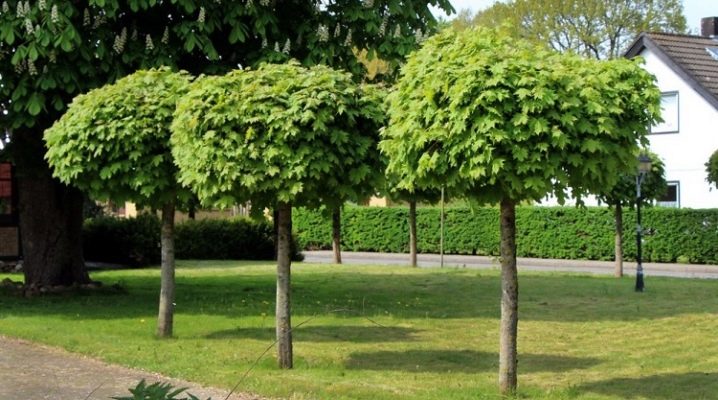
"Curly maple, carved" is familiar to everyone. It is often mentioned in poems and songs, which is not surprising, since maple is a very beautiful tree. Therefore, this plant is always in the first positions among landscape designers, and it is quite common in urban landscaping.
Most often, we think of maple as a tall tree with a dense, spreading crown, completely unsuitable for small gardens. But there are many of its species and varieties of compact form, there are even domestic dwarf representatives.

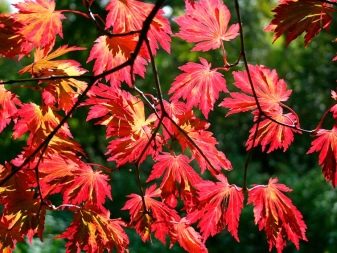
general characteristics
Maple as an ornamental crop is valued primarily for its interesting leaves. Moreover, in many varieties, the foliage has a bright color not only in autumn, but throughout the entire growing season. However, the dissected shape of the leaf plate is not typical for all species; there are also flowering maples. The inflorescences of some of them are very fragrant, which attracts pollinating insects. In addition, the seeds are also original and beautiful. An interesting surface of the bark, the color of the shoots, the structure of the crown, the remaining seed lionfish - all this allows maples to remain decorative and serve as a decoration of the site in winter.
It should be noted that compact forms are mostly demanding on soils, moisture content in the air and ground. But they are resistant to winds, relatively shade-tolerant. However, when planted in the shade, species with decorative foliage color lose their bright colors. All maples grow quite quickly and tolerate transplanting well. There are also low-growing frost-resistant varieties suitable for the Moscow region.
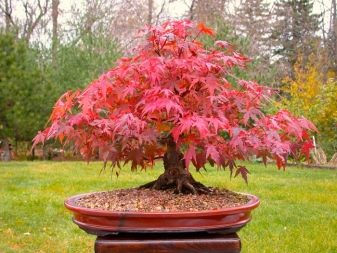
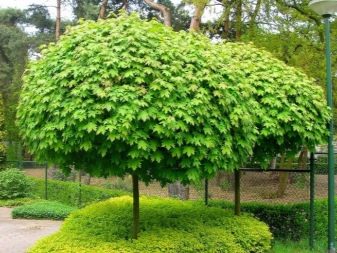
Types and varieties
Maple classification is very complex. Taking into account the peculiarities of leaves, inflorescences and fruits, the structure of the wood, experts have identified 17 sections. We list several groups and species that can be recommended for growing in small gardens in central Russia.
Holly
It is worth mentioning separately about this European variety, since the most famous maple in our country belongs to her. This tree (Acer platanoides) grows up to 30 m and forms a spreading tent-like crown. The usual species representatives for limited areas, of course, will not work. But there are several suitable varieties.
- Crimson Centry differs in purple foliage and attractive fragrant yellowish inflorescences. The tree can grow up to 10 m, but at the same time the characteristic feature of the Crimson Sentry is the columnar shape of the crown, which is not more than 3 m in diameter.
- Columnare also can reach a height of 10 m and has a compact columnar crown. The reddish tint of the leaves, which occurs when they bloom, subsequently disappears. The foliage is dark green.
- Globosum grows up to 7 m. Its peculiarity is a spherical crown. But in adult plants, it can acquire a flat shape, which can be corrected by pruning.

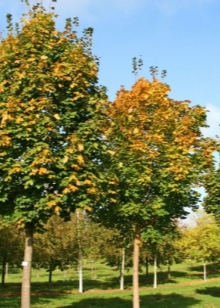
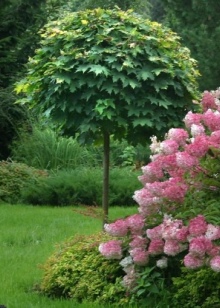
Far Eastern
In the Far East, maples grow everywhere, but they look different than European or North American ones.
One of the unpretentious and frost-resistant species is the Ginnala maple. These are small trees (up to 5 m) with a crown that has a wide conical shape. Maples of this species can also grow as multi-stem shrubs. Their deep-lobed leaves look especially beautiful in autumn, when they are painted in bright orange-red colors. The most interesting varieties:
- Durand dwarf - dwarf, grows only up to 60 cm, leaves are small, highly branched;
- Albovariegatum - differs in segmental white color of leaf plates;
- Pulverulentum - has white specks on the leaves.
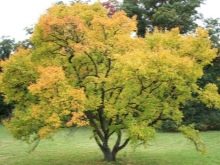
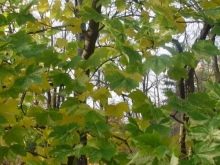
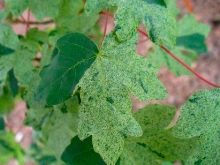
By the beauty of foliage and grace, the undisputed leaders will be the palm-shaped or fan-shaped maples (A. palmatum), which are very popular in Japan. They grow slowly, in width even faster than in height, they do not grow higher than 3-4 m. But for cultivation in central Russia, they have a significant disadvantage - low frost resistance. It is believed that some varieties can withstand temperatures as low as -29 ° C, but in practice, above the snow level, the shoots are frozen over.
Japanese gardening enthusiasts often buy the Dissectrum Atropurpureum variety, which has carved dark red leaves and almost purple leaves in mature plants. For the winter, he needs a solid shelter. In the Moscow region, such maples are best grown as a tub culture. The pseudosibold maple (A. pseudosieboldianum) can serve as a good substitute for the whimsical palm-shaped maple. It is a slender tree up to 8 m high. It has bright green deeply dissected leaves on scarlet petioles.
Also decorative are large racemose inflorescences and lionfish fruits, which are pinkish-red at the beginning of ripening, and then turn light brown.
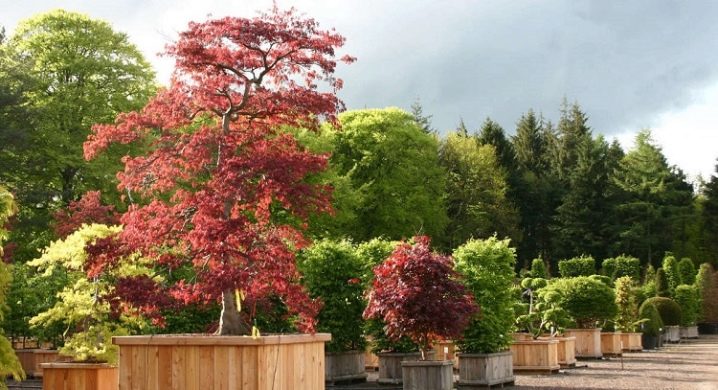
North American
The ash-leaved maple (A. negundo), which migrated to Russia from North America, is definitely known to everyone, because it has spread everywhere as a weed. It is curious that earlier it was grown in greenhouses. This species was brought in primarily because of its unpretentiousness, rapid growth and frost resistance. The decorative qualities of these maples are low, but there are also interesting varieties:
- Flamingo - a low (up to 4 m) tree or shrub, has variegated leaves, green with white-pink segments;
- Variegatum - grows up to 5 m, differs not only in decorative white-green leaves, but also in interesting large fruits.
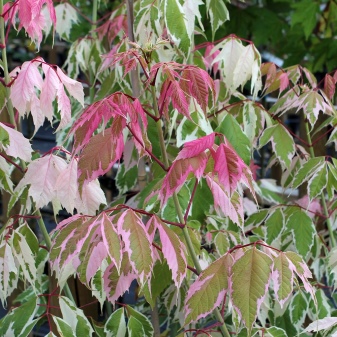
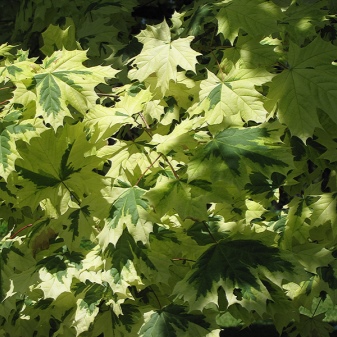
Shrub
Some maple species can form multiple trunks and appear as large shrubs. In addition to ash-leaved, pseudosibold and riverine, these include the bearded (A. barbinerve) with a spectacular violet-red bark, the large-flowered curled maple (A. circinatum) and the Tatar (A. tatarucum), characterized by fragrant white inflorescences. The main advantage of shrub species is that they tolerate pruning well.

Planting and leaving
To grow a maple tree, you need to choose the right place. Of all the listed species, the most undemanding are ash-leaved and Tatar (even tolerates salinization). Others are important to plant where there is sufficient light and there is no stagnant groundwater. The optimal composition of the soil for planting: humus, turf soil and sand in a ratio of 3: 2: 1, you can add peat. Most species are drought-resistant, but in hot summers, moderate watering will not be superfluous.
It is possible to propagate maples by cuttings, grafts (varietal) and seeds. The latter method is used most often. You can plant seeds in spring and autumn. It is best to collect them in September, when they begin to fall to the ground.
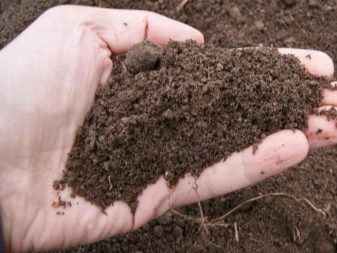

Spring planting
The collected seeds must be stored until spring. About 4 months before planting, you need to create conditions for them that resemble a state of winter dormancy. The planting material is placed in a container with wet sand and placed in a cold place (from 3 ° C to -5 ° C), thus the stratification process is carried out. Before planting, the seeds are germinated by soaking them for about 3 days in a solution of hydrogen peroxide.
Planted in open ground in early May. If then the plants will not be transplanted, then the distance between them should be at least 2 m. The taller the variety, the greater the spacing. The seeds are buried in the soil by about 4 cm.
You can first grow seedlings in a certain area. The first shoots should appear in 2-3 weeks, and when three leaves are deployed, young plants are seated in their places.During the season, maples grow by 30-40 cm, for the whole year - about 80 cm.
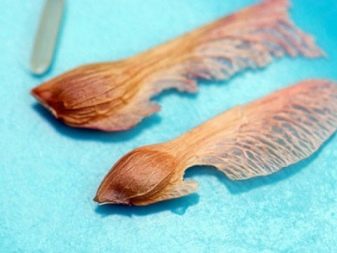
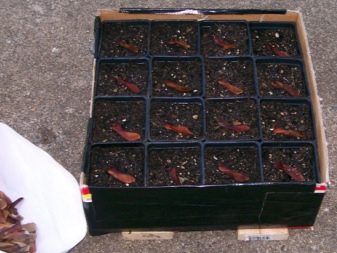
Autumn
Seeds can be planted before winter. In this case, stratification will occur naturally. Plants will adapt better in the future, but germination may decrease due to unfavorable winter factors: frost, small snow cover.
You can replant young maples in a year. For them, planting holes 50x70 cm are dug, with a close standing of groundwater, drainage is placed on the bottom: expanded clay, broken brick or small stones. Fill the pits with the above mixture.
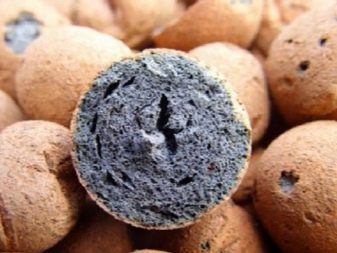
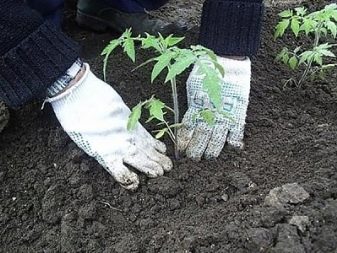
Use in garden design
The possibilities of using maples in the country or in gardening streets are quite wide. They are often used as tapeworms in open areas. Dwarf forms, especially with brightly colored leaves, look beautiful in color and contrasting compositions. Shrubby maples that tolerate shearing make excellent hedges.
Interestingly, the possibilities of using plants are not limited to this. Their wood is used to make furniture and musical instruments. And the name of the Canadian sugar maple (A. saccharum) speaks for itself; maple sugar is obtained from its juice.
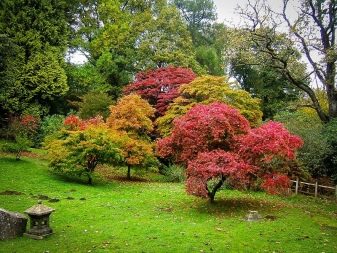
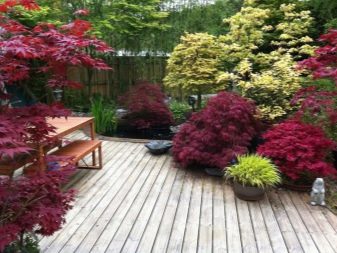
In the next video, an expert at the Greensad garden center will talk about how to properly propagate and plant maples.



































































The comment was sent successfully.